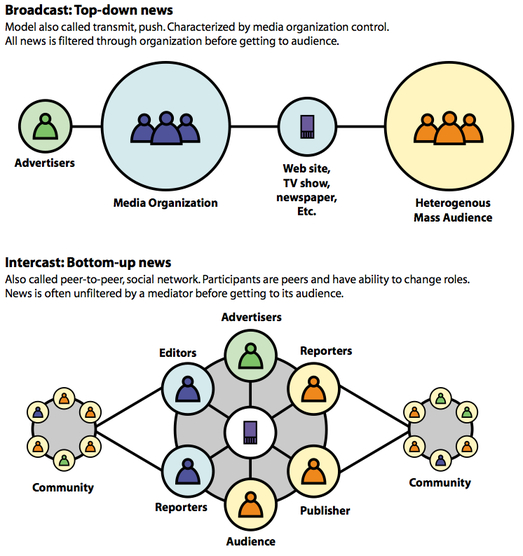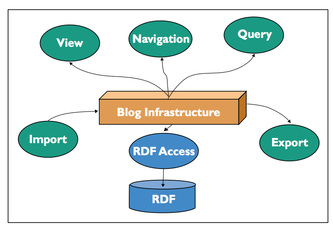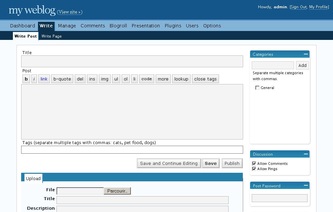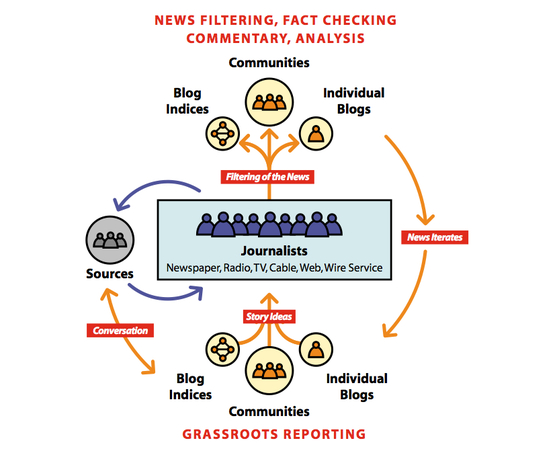Citizen Journalism
By Tom Roberts
Overview
The Prosumer practice of citizen journalism is one of the earliest forms of prosumerism. Because it principally involves the upload of text as it’s primary mode, it became the first predominant wave of prosumerism. This was determined by the early restrictions that the prosumer faced such as slow Internet speeds, minimal server storage amounts and the limited multimedia capabilities of the home pc. Whilst citizen journalism now exists across a number of online platforms to varying degrees, the weblog was the first prosumer mode to allow citizen journalism to become a significant online force.
In 1998 the amount of weblogs on the internet was so small that it was possible for Jesse James Garrett to compile a list of all the known blogs on the internet and at the beginning of 1999 the grand total of this list amounted to 23 weblogs. This list was then sent to Cameron Barrett who posted these known blogs on his website camworld. The process of compiling weblogs saw the beginning of the first prosumer community. Blood (1999) explains how ‘Suddenly a sprang up. It was easy to read all of the weblogs on Cameron's list, and most interested people did. Soon Barret was unable to keep track of all the weblogs that were appearing on the internet and had to only include on his website the sites which he followed himself.’.
This was the first wave in the rise in popularity of weblogs, it only lasted for a period of around 6 months. Things radically changed in July 1999 when the first first build your own weblog tool was launched. Blood (1999) explains that ‘In August, Pyra released Blogger, and Groksoup launched, and with the ease that these web-based tools provided, the bandwagon-jumping turned into an explosion. of the weblog’. This was the determinate factor in the upward trajectory of webloging and citizen journalism. Wortham (2007) explains that ‘Blogs have come a long way since Dec. 17, 1997, when Jorn Barger coined the term "weblog"’, ‘In the decade hence, blogs have come to dominate the net, from 100 million personal diaries to the breaking news sections of the august The New York Times.’.
It is important to make the distinction between the people who use weblogs recreationally \ and the people who distribute prosumer citizen journalist content via the weblog medium. Blood (2003) explains that ‘The early claim, “Weblogs are a new form of journalism,” has been gradually revised to “some Weblogs are doing journalism, at least part of the time.”.’. Not all online blogging constitutes as citizen journalism, some bloggers are merely recording an online interactive diary, or participating more holistically with the online environment. Bowan and Willis (2003, p.9) define citizen journalism as “the act of a citizen, or group of citizens, playing an active role in the process of collecting, reporting, analysing and disseminating news and information.’, resulting from ‘many simultaneous, distributed conversations that either blossom or quickly atrophy in the webs social network’.
The other important distinction to make is that not all weblogs that generate journalistic material are generated by prosumers, many are maintained by conventional news organizations and journalists. Blood (2003) breaks down the different kind of weblogs as being as follows.
The former of the two weblogs does not constitute a prosumer-based media. For the purposes of this case study the latter two kinds of weblog will be examined. Hopefully highlighting their relevance to the contemporary media practitioner.
In 1998 the amount of weblogs on the internet was so small that it was possible for Jesse James Garrett to compile a list of all the known blogs on the internet and at the beginning of 1999 the grand total of this list amounted to 23 weblogs. This list was then sent to Cameron Barrett who posted these known blogs on his website camworld. The process of compiling weblogs saw the beginning of the first prosumer community. Blood (1999) explains how ‘Suddenly a sprang up. It was easy to read all of the weblogs on Cameron's list, and most interested people did. Soon Barret was unable to keep track of all the weblogs that were appearing on the internet and had to only include on his website the sites which he followed himself.’.
This was the first wave in the rise in popularity of weblogs, it only lasted for a period of around 6 months. Things radically changed in July 1999 when the first first build your own weblog tool was launched. Blood (1999) explains that ‘In August, Pyra released Blogger, and Groksoup launched, and with the ease that these web-based tools provided, the bandwagon-jumping turned into an explosion. of the weblog’. This was the determinate factor in the upward trajectory of webloging and citizen journalism. Wortham (2007) explains that ‘Blogs have come a long way since Dec. 17, 1997, when Jorn Barger coined the term "weblog"’, ‘In the decade hence, blogs have come to dominate the net, from 100 million personal diaries to the breaking news sections of the august The New York Times.’.
It is important to make the distinction between the people who use weblogs recreationally \ and the people who distribute prosumer citizen journalist content via the weblog medium. Blood (2003) explains that ‘The early claim, “Weblogs are a new form of journalism,” has been gradually revised to “some Weblogs are doing journalism, at least part of the time.”.’. Not all online blogging constitutes as citizen journalism, some bloggers are merely recording an online interactive diary, or participating more holistically with the online environment. Bowan and Willis (2003, p.9) define citizen journalism as “the act of a citizen, or group of citizens, playing an active role in the process of collecting, reporting, analysing and disseminating news and information.’, resulting from ‘many simultaneous, distributed conversations that either blossom or quickly atrophy in the webs social network’.
The other important distinction to make is that not all weblogs that generate journalistic material are generated by prosumers, many are maintained by conventional news organizations and journalists. Blood (2003) breaks down the different kind of weblogs as being as follows.
- Those written by journalists;
- Those written by professionals about their industry;
- Those written by individuals at the scene of a major event;
- Those that link primarily to news about current events.
The former of the two weblogs does not constitute a prosumer-based media. For the purposes of this case study the latter two kinds of weblog will be examined. Hopefully highlighting their relevance to the contemporary media practitioner.
A simple Breakdown of the way blogging has reveloutianized the news world.
Understanding the Place of Citizen Journalism in the Contemporary Media Environment.
Key differences between the old media, of conventional journalism and the new media, of bogging/citizen journalism is evident through the intrinsic flaws in the respective production and consumption models. Although the respective media do have unique capabilities and resources that are easily defined and examined, it is the underlying inability of each media to fulfill a certain consumer desire that emphasizes the most crucial differences. These are differences, which have concurrently given rise to citizen journalism/blogging, whilst also determining the ongoing importance of conventional news media in the face of convergence.
The key to understanding the way in which blogging has revolutionized the current news media landscape is in determining how it has filled a void, which existed in the pre-existing old media. Flew (2008, p. 151) states that “the internet emerged at a time of perceived crisis for journalism, arising from a sense of growing disconnect between journalism as an organized and institutionalized professional practice and the audiences and communities that it intended to serve.”. This sense of growing disconnect between professional practice and audiences/communities which coincided with a significant technological advancement (the Internet and access to it) facilitated the birth of citizen Journalism.
In contrast to the pre-existing news media, citizen journalism was ideologically grounded in what Rosen (cited in Flew, 2008, p.151) describes as ‘seeing people as citizens rather than as spectators, readers, viewers, listeners or an undifferentiated mass.’. This ideological conception is perhaps only of relevance once considered in relation to the production values employed by each media. Lasica (2003, p. 71) explains that ‘Mainstream news operations are businesses supported by advertising. As hihierachical organizations they value smooth production workflows, profitability and rigorous editorial standards’. These values are in stark contrast to those employed by citizen journalists which Lasica (2003, p. 71) explains ‘value in-formal conversation, egalitarianism, subjective points of view and colorful writing, over profits objectivity and filtered prose’. This distinction between the production values of the respective production models, although simplistic, clearly defines an ideological difference. It also highlights the ability of citizen Journalists to work free from the constraints of traditional news media, allowing them to preference a different set of values, in turn filling a void left by the traditional news media.
As has been defined the practice of citizen journalism, was a direct reaction to a preexisting media form. These foundations have defined the growth of citizen journalism, and its reactionary beginnings have simultaneously solidified the importance of conventional news media. Although Citizen journalism has the ability to connect with its audience directly, it lacks many of the resources that are provided to conventional news media. This is why in over a decade of citizen journalism there has not been an emergence of a significant primary online news media resource. Whilst it was an ideological shift coinciding with the advance in technology that gave rise to citizen journalism, it is practical realities that have ensured the ongoing importance of traditional news media. These realities can be broken down into two categories, structure and resources.
The key differences evident in the respective media underpin an underlying tension which has shaped the current news media landscape into what it is today. It is the basic core ideological differences between each media form, which have simultaneously determined the rise of citizen journalism, whilst also contextualizing the shortcomings of the pre-existing news media. It is these shortcomings, which have dictated a resulting deconstruction of the pre-existing news media production and consumption models. This is to say that there has been a dismantling and reformation of the pre-existing news media business structures as a result of the rise in citizen journalism (Dwyer & Nightingale, 2007). Although Blogs and citizen journalists are here to stay, conventional news media has adapted to the major shift in the media environment, the two spheres of journalism have reached somewhat of an equilibrium.
This diagram helps explain the different production and consumtion models, which determine the vastly different production and consumtion models of prosumer and conventional news media.
The key to understanding the way in which blogging has revolutionized the current news media landscape is in determining how it has filled a void, which existed in the pre-existing old media. Flew (2008, p. 151) states that “the internet emerged at a time of perceived crisis for journalism, arising from a sense of growing disconnect between journalism as an organized and institutionalized professional practice and the audiences and communities that it intended to serve.”. This sense of growing disconnect between professional practice and audiences/communities which coincided with a significant technological advancement (the Internet and access to it) facilitated the birth of citizen Journalism.
In contrast to the pre-existing news media, citizen journalism was ideologically grounded in what Rosen (cited in Flew, 2008, p.151) describes as ‘seeing people as citizens rather than as spectators, readers, viewers, listeners or an undifferentiated mass.’. This ideological conception is perhaps only of relevance once considered in relation to the production values employed by each media. Lasica (2003, p. 71) explains that ‘Mainstream news operations are businesses supported by advertising. As hihierachical organizations they value smooth production workflows, profitability and rigorous editorial standards’. These values are in stark contrast to those employed by citizen journalists which Lasica (2003, p. 71) explains ‘value in-formal conversation, egalitarianism, subjective points of view and colorful writing, over profits objectivity and filtered prose’. This distinction between the production values of the respective production models, although simplistic, clearly defines an ideological difference. It also highlights the ability of citizen Journalists to work free from the constraints of traditional news media, allowing them to preference a different set of values, in turn filling a void left by the traditional news media.
As has been defined the practice of citizen journalism, was a direct reaction to a preexisting media form. These foundations have defined the growth of citizen journalism, and its reactionary beginnings have simultaneously solidified the importance of conventional news media. Although Citizen journalism has the ability to connect with its audience directly, it lacks many of the resources that are provided to conventional news media. This is why in over a decade of citizen journalism there has not been an emergence of a significant primary online news media resource. Whilst it was an ideological shift coinciding with the advance in technology that gave rise to citizen journalism, it is practical realities that have ensured the ongoing importance of traditional news media. These realities can be broken down into two categories, structure and resources.
The key differences evident in the respective media underpin an underlying tension which has shaped the current news media landscape into what it is today. It is the basic core ideological differences between each media form, which have simultaneously determined the rise of citizen journalism, whilst also contextualizing the shortcomings of the pre-existing news media. It is these shortcomings, which have dictated a resulting deconstruction of the pre-existing news media production and consumption models. This is to say that there has been a dismantling and reformation of the pre-existing news media business structures as a result of the rise in citizen journalism (Dwyer & Nightingale, 2007). Although Blogs and citizen journalists are here to stay, conventional news media has adapted to the major shift in the media environment, the two spheres of journalism have reached somewhat of an equilibrium.
This diagram helps explain the different production and consumtion models, which determine the vastly different production and consumtion models of prosumer and conventional news media.
Production Tools
The production tools which have determined the rise of the prosumer practice of citizen journalism are some of the most basic. They have an indiscriminative quality, which allows for diversity in the people who produce citizen journalist weblogs. This diversity is an important feature of the “prosumer way”. Big media corporations and institutions can discriminate against certain information sources, groups within the community or individuals themselves. Because of the very nature of weblog production tools and what Jenkins (2006, p. 210) describe as the ‘the webs low barriers to entry’ conventional filtration methods used by conventional media producers are no longer an issue. In order to perform an act of citizen journalism Lasica (2003, p.73) explains that ‘you don’t need a big-league publication with a slick website behind you. All you need is a computer an Internet connection and an ability to perform a few tricks of the trade’.
Lasisca’s assertion defines the means by which citizen journalists produce their content as being limited to two core elements, Internet access and the home pc. Although access to the Internet does not initially constitute a production tool. Because the nature of the majority of citizen journalism is dependant upon access to online blogging tools in the way of hosting which involves editing capabilities. As well as being reliant on the ability to include hyperlinks to material within the content they produce which they are directly responding to. The importance of the Internet not only in terms distribution but also the production process cannot be overstated.
Perse & Dunn (1998) explain that through connections made to networks via the Internet the home computer is changed from an information processor to a communication medium. This is primarily what gave rise to the first wave of prosumer media content production and dissemination, this being weblogging. Flew (2008, p.4) explains that ‘while convergence has now spread across a range of platforms and devices, it was the emergence and mass popularisation of the internet that heralded the rise of new media, understood as bringing together computing and information technologies communication networks and media content’. This predominantly explains the how and why of the production tools used by bloggers, however the role of online publishing means must be further explored to understand the production process.
The kinds of editing and publishing tools available to the prosumer citizen journalist are outlined by Du and Wagner (2006, p.790) as having the following characteristics:
Personalized: designed for individual use. Their style is personal and informal.
Web-based: Weblogs can be updated frequently. They are easy to maintain and accessible via a web browser.
Community-supported: Weblogs can link to other weblogs and websites, enabling the linkage of ideas, and hence stimulating knowledge generation and shar- ing between bloggers.
Automated: Blogging tools help bloggers to present their words without the hassle of writing HTML code or program; instead, bloggers just need to concentrate on the content.
This contextualizes the ways in which prosumer weblogers can use the online production tools provided through Internet access to produce content, link in content, share content and establish online communities. It Is amazing to think that through these basic tools it is possible for individuals to independently produce and publish their own journalistic work, potentially reaching niche audiences and mass audiences alike.
Below are some images that show how the online production tools of a weblog work, as well as some of the common tools used by citizen journalists to record and capture content.
Lasisca’s assertion defines the means by which citizen journalists produce their content as being limited to two core elements, Internet access and the home pc. Although access to the Internet does not initially constitute a production tool. Because the nature of the majority of citizen journalism is dependant upon access to online blogging tools in the way of hosting which involves editing capabilities. As well as being reliant on the ability to include hyperlinks to material within the content they produce which they are directly responding to. The importance of the Internet not only in terms distribution but also the production process cannot be overstated.
Perse & Dunn (1998) explain that through connections made to networks via the Internet the home computer is changed from an information processor to a communication medium. This is primarily what gave rise to the first wave of prosumer media content production and dissemination, this being weblogging. Flew (2008, p.4) explains that ‘while convergence has now spread across a range of platforms and devices, it was the emergence and mass popularisation of the internet that heralded the rise of new media, understood as bringing together computing and information technologies communication networks and media content’. This predominantly explains the how and why of the production tools used by bloggers, however the role of online publishing means must be further explored to understand the production process.
The kinds of editing and publishing tools available to the prosumer citizen journalist are outlined by Du and Wagner (2006, p.790) as having the following characteristics:
Personalized: designed for individual use. Their style is personal and informal.
Web-based: Weblogs can be updated frequently. They are easy to maintain and accessible via a web browser.
Community-supported: Weblogs can link to other weblogs and websites, enabling the linkage of ideas, and hence stimulating knowledge generation and shar- ing between bloggers.
Automated: Blogging tools help bloggers to present their words without the hassle of writing HTML code or program; instead, bloggers just need to concentrate on the content.
This contextualizes the ways in which prosumer weblogers can use the online production tools provided through Internet access to produce content, link in content, share content and establish online communities. It Is amazing to think that through these basic tools it is possible for individuals to independently produce and publish their own journalistic work, potentially reaching niche audiences and mass audiences alike.
Below are some images that show how the online production tools of a weblog work, as well as some of the common tools used by citizen journalists to record and capture content.
Communities.
Prosumer communities were perhaps the most important component in the rise of prosumer culture. Citizen journalism communities are vital to the distribution, promotion and filtration of the masses of citizen journalist content online. It is important to understand the value systems of which these online communities are based upon. Lasisca (2003, p.71) explains that citizen journalist communities adhere to a different set of values to those that are employed by mainstream media, stating ‘bloggers value informal conversation, egalitarianism, subjective points of view and colourful writing over profits, central control, objectivity and filtered prose.’. This defines what prosumer communities value in terms of production, however what social and ideological values govern the citizen journalist communities? Witt (2004, p.51) explains that citizen journalist communities ‘want to ensure that the voice of the public is heard and that not all reporting is top-down; that all communities, even marginalized ones, are listened to so that spin doc- tors do not control our elections; and that we hear from the middle spectrum of ideas as well as from the polar extremes.’.
The importance of weblog communities to the dissemination and production process is hardwired into the online software that webloggers use to create their content Du and Wagner state that (2006, p.790) ‘Community-supported. Weblogs can link to other weblogs and websites, enabling the linkage of ideas, and hence stimulating knowledge generation and sharing.’ This is something that is known as the “other blog value”, which citizen journalist communities are founded upon.
Shirky (in Lasisca 2003, p. 71) explains that the difference between weblog communities and the institutions of traditional news media is that the order in traditional broadcast structures is filter then publish, where as citizen journalists communities publish then filter. This essentially underpins almost all prosumer production, the ability to bypass larger institutions through the uses of cheap equipment and ability to access the web is what allows for the production of content, but it is the online communities, which determines the promotion of this content and its eventual success. The communities, by promoting work are essentially acting as a filtration system, sourcing the best content and making it easier for interested parties to find, working to generate an audience. Bowman & Willis (2003) explain that the communities are essential to the emerging online ecosystem, fact checking and developing resource pools.
Online prosumer communities also perform an important role as educational tools. Kern & Nam (2008, pp.25) explain how online communities would instruct ‘ordinary citizens about how to gather journalistic information in a "professional" way’ whilst also introducing ‘review procedures in order to raise the quality of non-professional contributions to on- line newspapers or communities.’. This is essential to the continuation of citizen journalism and to the maintaining of a high standard of citizen journalist work
Essentially the importance of the online citizen journalist’s community is evident in these three factors.
The dissemination of content.
The education of the members of the community.
The filtration that the communities provide allowing the growth of a consumer base.
The importance of weblog communities to the dissemination and production process is hardwired into the online software that webloggers use to create their content Du and Wagner state that (2006, p.790) ‘Community-supported. Weblogs can link to other weblogs and websites, enabling the linkage of ideas, and hence stimulating knowledge generation and sharing.’ This is something that is known as the “other blog value”, which citizen journalist communities are founded upon.
Shirky (in Lasisca 2003, p. 71) explains that the difference between weblog communities and the institutions of traditional news media is that the order in traditional broadcast structures is filter then publish, where as citizen journalists communities publish then filter. This essentially underpins almost all prosumer production, the ability to bypass larger institutions through the uses of cheap equipment and ability to access the web is what allows for the production of content, but it is the online communities, which determines the promotion of this content and its eventual success. The communities, by promoting work are essentially acting as a filtration system, sourcing the best content and making it easier for interested parties to find, working to generate an audience. Bowman & Willis (2003) explain that the communities are essential to the emerging online ecosystem, fact checking and developing resource pools.
Online prosumer communities also perform an important role as educational tools. Kern & Nam (2008, pp.25) explain how online communities would instruct ‘ordinary citizens about how to gather journalistic information in a "professional" way’ whilst also introducing ‘review procedures in order to raise the quality of non-professional contributions to on- line newspapers or communities.’. This is essential to the continuation of citizen journalism and to the maintaining of a high standard of citizen journalist work
Essentially the importance of the online citizen journalist’s community is evident in these three factors.
The dissemination of content.
The education of the members of the community.
The filtration that the communities provide allowing the growth of a consumer base.
Distribution.
The unique distribution strategies and systems used in the prosumer, citizen journalist community, is what essentially separates the weblog medium from conventional media systems. How though do citizen journalists still present a formidable force online, when they are still in direct competition with conventional media institutions on the web. Flew (2008, p.145) states that ‘to achieve substantive changes in the concentration, organisation and uses of media what need’s to be looked at are;
1. New ways of consuming media, which explicitly contest the social legitimacy of media power;
2. New infrastructures of production, which have an impact upon who can produce media and in what circumstances;
3. New infrastructures of distribution, which change the scale and terms on which media and other forms of symbolic production in one place can reach other places.
The impact that a revolution in production tools, which citizen journalists used, has already been established however, how have “infrastructures of distribution” changed the concentration, organisation and uses of media?. Kern & Nam, (2008, p.9) explain that ‘The activists of the so- called independent media movement criticized the unequal distribution of power and influence between the established mass media and their audience and demanded a higher degree of participation by ordinary citizens’. This is what led to the initial wave of the citizen journalist movement. As conventional media makers were wary of the potential of the Internet, prosumer citizen journalism was able to grow an online audience. The first wave of citizen journalist distribution methods were very basic and consisted primarily of the weblog its self; members of the blogging community would share and promote each other’s content. This circulation method was a formidable online presence and helped to keep the blogging community strong. The ability to hyperlink was essential in this first wave of distribution as it allowed webloggers to generate a network which promoted the community of citizen journalists.
It wasn’t long before conventional media makers realized that they had to begin to establish an online presence in order to keep up with the shifting cultural consumption practices that the Internet had determined. Dwyer, & Nightingale (2007) explain that the conventional media institutions had to address the changing character of content, changing character of audience formations and then structurally adapting on technological, industrial, cultural and social levels. Conventional media has now successfully adapted and have established a strong online presence. As a result of this, prosumer citizen journalists are now competing with the weblogs of conventional journalists and media institutions.
So how has the prosumer citizen journalist community stayed competitive with the powerful media institutions? Essentially the same prosumer network has been primarily responsible for ensuring the continued success of citizen journalism, sites run by the citizen journalist community such as http://www cyberjournalist.net, are one example of how the prosumer community acts to distribute the work of citizen journalists. The technologies of web 2.0 have allowed prosumers to distribute their media across a much greater range of web based platforms, citizen journalists today will take a multiplatform approach to distribution, using social media tools such as facebook and twitter, as well as you tube and flickr in order to dynamically promote their work. A particularly interesting distribution method that has arisen in the last 5 years or so is privatized websites. These are primarily money-making business which use citizen journalist content to fill their sites pages. These sites essentially contract prosumer journalists to contribute work, they have links on their home pages which describe how prosumers can participate not only story content, but also pictures and videos examples of this are sites like http://www.broadsheet.com.au/ and http://www.thevine.com.au/.
Essentially the first wave of the prosumer generation did affect the “infrastructures of distribution” dramatically, however since old media institutions have effectively adapted, citizen journalist distribution models need to continue to adapt.
1. New ways of consuming media, which explicitly contest the social legitimacy of media power;
2. New infrastructures of production, which have an impact upon who can produce media and in what circumstances;
3. New infrastructures of distribution, which change the scale and terms on which media and other forms of symbolic production in one place can reach other places.
The impact that a revolution in production tools, which citizen journalists used, has already been established however, how have “infrastructures of distribution” changed the concentration, organisation and uses of media?. Kern & Nam, (2008, p.9) explain that ‘The activists of the so- called independent media movement criticized the unequal distribution of power and influence between the established mass media and their audience and demanded a higher degree of participation by ordinary citizens’. This is what led to the initial wave of the citizen journalist movement. As conventional media makers were wary of the potential of the Internet, prosumer citizen journalism was able to grow an online audience. The first wave of citizen journalist distribution methods were very basic and consisted primarily of the weblog its self; members of the blogging community would share and promote each other’s content. This circulation method was a formidable online presence and helped to keep the blogging community strong. The ability to hyperlink was essential in this first wave of distribution as it allowed webloggers to generate a network which promoted the community of citizen journalists.
It wasn’t long before conventional media makers realized that they had to begin to establish an online presence in order to keep up with the shifting cultural consumption practices that the Internet had determined. Dwyer, & Nightingale (2007) explain that the conventional media institutions had to address the changing character of content, changing character of audience formations and then structurally adapting on technological, industrial, cultural and social levels. Conventional media has now successfully adapted and have established a strong online presence. As a result of this, prosumer citizen journalists are now competing with the weblogs of conventional journalists and media institutions.
So how has the prosumer citizen journalist community stayed competitive with the powerful media institutions? Essentially the same prosumer network has been primarily responsible for ensuring the continued success of citizen journalism, sites run by the citizen journalist community such as http://www cyberjournalist.net, are one example of how the prosumer community acts to distribute the work of citizen journalists. The technologies of web 2.0 have allowed prosumers to distribute their media across a much greater range of web based platforms, citizen journalists today will take a multiplatform approach to distribution, using social media tools such as facebook and twitter, as well as you tube and flickr in order to dynamically promote their work. A particularly interesting distribution method that has arisen in the last 5 years or so is privatized websites. These are primarily money-making business which use citizen journalist content to fill their sites pages. These sites essentially contract prosumer journalists to contribute work, they have links on their home pages which describe how prosumers can participate not only story content, but also pictures and videos examples of this are sites like http://www.broadsheet.com.au/ and http://www.thevine.com.au/.
Essentially the first wave of the prosumer generation did affect the “infrastructures of distribution” dramatically, however since old media institutions have effectively adapted, citizen journalist distribution models need to continue to adapt.
Conclusion
As has essentially been established the initial weblogs/citizen journalism versus traditional print media/traditional journalism debate has essentially been resolved. Somewhat of equilibrium has been met between the two, traditional news sources understand that citizen journalism is not a threat to their organizations. This is for two main reasons, one being because traditional news provides a very different form of reporting, which still is the proffered news form for the majority of the audience, the other reason is because the majority of citizen journalist content acts in direct reaction to the news stories produced by the old media institutions. Citizen Journalism is predominantly an online continuation of the news, this is not a devaluation of citizen journalism, on the contrary, it is this continuation that has drastically altered the traditional medias approach to their audience. Conventional news media institutions have now established formidable online presences, they now embrace blogs and social media, interacting with their audience.
So more than a decade on from when citizen journalism first emerged striking fear into the hearts of journalist everywhere, is citizen journalism still an important news source? The answer is unequivocally yes, just as conventional news media had to adapt to the rise of citizen journalism, so has the citizen journalism communities had to adapt to the presence conventional media institutions have formed online. Citizen journalist communities are strong and their ability to source unique and spontaneous material and bypass the traditional filtration systems, means that the content they produce is always of interest to someone. It’s just a matter of finding an audience, the communities of the citizen journalist movement are constantly promoting and distributing the content produced within their communities, whilst also educating the members of that community. This provides for the continuation of the citizen journalist movement and as private companies now source the content of citizen journalism, in the form of websites which act as online hubs of information. Citizen journalists have their own more conventional online news distribution infrastructure, whilst also maintaining their grass roots core.
So how does this apply to the modern media practitioner? Essentially Convergence culture has shaped the changes in the media industry over the last decade. It is important for modern day media makers to be aware of the new ways media is being consumed and produced. As the online media paradigm cultivates niche communities and markets by which the industry needs to cater for, it is important for the modern day practioner to be aware of these groups and assess which markets they wish to reach. Being involved with the citizen journalist community still provides the most effective way for content producers to do this. Citizen journalism communities cultivate a grassroots media source, which educates and encourages its members. As the community now extends to privatized distribution sources and content is often used by conventional media sources, this community serves as an exceptional means for aspiring journalists and content producers to gain experience, become employed or get published. Only through communities formed online such as that of the citizen journalist, can media makers contribute unique material cost effectively, potentially gaining attention from their community, media professionals and an audience.
So more than a decade on from when citizen journalism first emerged striking fear into the hearts of journalist everywhere, is citizen journalism still an important news source? The answer is unequivocally yes, just as conventional news media had to adapt to the rise of citizen journalism, so has the citizen journalism communities had to adapt to the presence conventional media institutions have formed online. Citizen journalist communities are strong and their ability to source unique and spontaneous material and bypass the traditional filtration systems, means that the content they produce is always of interest to someone. It’s just a matter of finding an audience, the communities of the citizen journalist movement are constantly promoting and distributing the content produced within their communities, whilst also educating the members of that community. This provides for the continuation of the citizen journalist movement and as private companies now source the content of citizen journalism, in the form of websites which act as online hubs of information. Citizen journalists have their own more conventional online news distribution infrastructure, whilst also maintaining their grass roots core.
So how does this apply to the modern media practitioner? Essentially Convergence culture has shaped the changes in the media industry over the last decade. It is important for modern day media makers to be aware of the new ways media is being consumed and produced. As the online media paradigm cultivates niche communities and markets by which the industry needs to cater for, it is important for the modern day practioner to be aware of these groups and assess which markets they wish to reach. Being involved with the citizen journalist community still provides the most effective way for content producers to do this. Citizen journalism communities cultivate a grassroots media source, which educates and encourages its members. As the community now extends to privatized distribution sources and content is often used by conventional media sources, this community serves as an exceptional means for aspiring journalists and content producers to gain experience, become employed or get published. Only through communities formed online such as that of the citizen journalist, can media makers contribute unique material cost effectively, potentially gaining attention from their community, media professionals and an audience.








